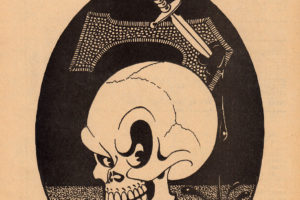 An interesting little book I’ve had for a while is Atomic Age Treasury of Pulp Action, Vol. 1. Published in 2004 by Ape Entertainment, a comicbook publisher that seemed to briefly wander into doing books. It was packaged by Atomic Age Studios. I’m not aware of any second volume or further works from the authors in the new pulp world.
An interesting little book I’ve had for a while is Atomic Age Treasury of Pulp Action, Vol. 1. Published in 2004 by Ape Entertainment, a comicbook publisher that seemed to briefly wander into doing books. It was packaged by Atomic Age Studios. I’m not aware of any second volume or further works from the authors in the new pulp world.
A trade paperback, the book has a cover designed to look like a beat-up book, dog-eared with wear along the edges. The cover features the pulp hero who stars in this volume: The Crimson Devil, who wears a cowboy-inspired outfit and fights crime. He is joined by some other characters like American Star, who seems more a comicbook character with her superpowers (who also stars in her own movie serials); another masked vigilante, Fear; and underwater adventurer Davey Jones, who is prince of the sunken city of Mu (another character who seems more comicbook than pulp). They were created by editor Brent E. Erwin, though the four stories are written by others: Mike Hall, Bob Elinsksas, and David Michael Wharton.
Troubling is the mixing of genres. Pulps aren’t really something from the “atomic age,” and we are told this work comes from the the “Golden Age of 1940s comics.” Uh, no. Pulp fiction comes from the pulp magazines of the 1930s and ’40s, not the comics. Overall, there is just too much comicbook influence in these stories (as well as influence from movie serials).
So let’s look at the stories. Most star the character The Crimson Devil. While a vigilante-type hero, he actually works for the government, something called the Bureau of the Unknown. His sometime associate is the superheroine American Star, also part of the same group. So they don’t have to worry about the cops. First story has The Crimson Devil look into a pulp magazine publisher putting out a pulp starring him, and finding out it’s being used to pass coded messages to the Axis powers. Next story has The Crimson Devil dealing with attempts to kill the director of American Star’s latest movie serial by someone called The Ghost, which all points to past crimes.
The third story actually features Fear dealing with an Axis assassin named Der Vapor, who is similar to the old Starman villain The Mist. Fear is shown to using a mystic amulet to stop Der Vapor. The fourth story is the longest. Set in Puerto Rico, it has The Crimson Devil and American Star in their civilian identities there to meet someone that The Crimson Devil has dealt with before. We also learn more of his origin, which has some mystical elements, and that Fear was his mentor. There is a problem going on in the sea, which may be caused by Nazis operating near the sunken city of Mu. It’s some lovecraftian-type monster, and the pair meet Davey Jones and the Crimson Devil puts an end to it and frees the people of Mu.
As I noted, there is a bit too much comicbook influence and general ignorance of the pulp magazines. People refer to The Crimson Devil as just “CD,” which strikes me as too modernistic. In the first story, the pulp magazine publisher has a similar name to Street & Smith, as if this name will fool customers into buying the magazines. But readers bought mags based on the genre, not the publisher. Unlike comicbooks, readers were unlikely to buy all the pulps from a single publisher and ignore them from others, and the publisher names were not as prominent (some are absent) on the covers, unlike comicbooks. They’d more likely buy similar titles than pulps from a similarly named publisher.
American Star is clearly a comicbook character with her superpowers, not a pulp character. And the mystic elements of Fear and The Crimson Devil are too comicbookish as well. Same goes for Davey Jones. And Mu is a lost continent in the Pacific, not the Atlantic. I also thought it funny that the artwork for the last story showed Cuba, when the story was set in Puerto Rico. Someone flubbed.
Frankly, if these authors were big pulp fans, I would expect them to be putting out new pulp stories today. But I don’t see them.
It’s an interesting item. I’m not sure how easy it will be to find a copy. They kind of missed the New Pulp movement.



